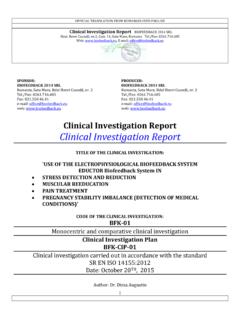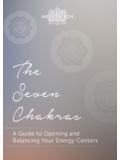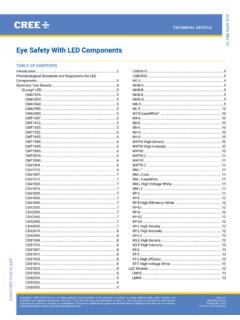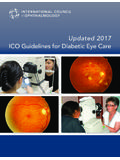Transcription of Author - Editor: Professor of Medicine Desire’ …
1 Author - editor : Professor of Medicine desire Dubounet, D. Sc. April 30, 2015 for Medical Expose Light synchronizes our internal clock .. 3 1. Melatonin .. 14 2. Oregano Oil and Neem Extract .. 14 3. Raw Cacao .. 15 4. Chlorophyll-rich Superfoods .. 15 5. Raw Apple Cider Vinegar .. 16 6. Iodine .. 16 7. Organic Blue Ice Skate Fish Oil and Activator X (Vitamin K1/K2) .. 16 8. Boron/Borax .. 17 Key Protein is Linked to Circadian Clocks, Helps Regulate Metabolism .. 17 Study Sheds Light on Molecular Basis for Metabolic Health and Disease .. 17 .. 19 Key Protein Found Throughout the Body .. 19 P75 NTR s Impact on Circadian Clock SystemsThe human pineal gland and melatonin in aging and Alzheimer's disease.
2 20 Author information .. 20 Abstract .. 20 .. 21 Pineal Gland Disease and DisordersPineal Gland .. 24 .. 28 Circadian rhythm and the PinealHistory .. 28 Criteria .. 29 Origin .. 29 Importance in animals .. 30 Impact of light dark 31 Arctic animals .. 31 Butterfly migration .. 31 In plants .. 32 Biological clock in mammals .. 33 Determining the human circadian rhythm .. 34 Outside the "master clock" .. 35 Physiology .. 35 Use of red lights .. 36 Light and the biological clock .. 36 Enforced longer cycles .. 37 Human health .. 38 Circadian rhythm and airline pilots .. 38 38 Effect of drugs .. 39 Light synchronizes our internal clock Light does us good. We experience that every year at the beginning of spring.
3 As the days get brighter and longer, we feel fitter, our spirits rise and we are generally more focused and more productive than in the dark winter months. This shows that we need light for more than just vision. Recent studies confirm that light has another important function: it synchronises our internal clock the complex system that coordinates all our bodily functions in a 24-hour rhythm. third photoreceptor in the eye The biological effectiveness of light is possible thanks to a third photoreceptor in the eye discovered by scientists in 2002. Prior to that, only two types of receptor were known: cones for colour vision and more light-sensitive rods, which enable us to see even when illuminanceis low.
4 But a few years ago, researchers discovered special ganglion cells in the retina that do not have a visual function. They contain a light-sensitive pigment called melanopsin and respond very sensitively to the blue content of light. The newly discovered photoreceptors have a direct link to the brain: the ganglion cells send signals through the retino-hypothalamic tract, which connects them directly with the so-called master clock the suprachiasmatic nucleus (SCN) that coordinates the many tiny clocks in the body the pineal gland and the hypothalamus, which is probably the most important control centre of the autonomous nervous system. Hormones as messenger substances Melanopsin receptors are evenly spread over the retina and are most sensitive in the lower part of it.
5 They supply the brain with information that helps determine whether we are alert or sleepy because the light signals they pass on are an important cue for synchronising our circadian rhythms, the biological processes that occur in cycles of around 24 hours. The messenger substances of the internal clock providing the driving force for the sleep/wake rhythm are hormones. Melatonin and cortisol, in particular, play an important role here because they impact on the body in opposite cycles. Melatonin makes us feel drowsy and slows down bodily functions for a good night's sleep. The organism is put, as it were, on the back burner. In this phase, the body secretes growth hormones that repair cells at night.
6 In the morning, the level of melatonin in the blood falls. From around 3 onwards, the adrenal cortex produces cortisol, a stress hormone that stimulates metabolism and programmes the body for day-time operation. The mood-enhancing, motivating messenger seratonin helps us reach a number of performance peaks during the day. During the course of the afternoon, the cortisol level in the blood falls and, when daylight fades, the internal clock switches to night. Biologically effective light raises spirits But to work smoothly, our body's hormone balance needs to be supported by external stimuli. That calls for the right light. Light with a high blue content in the morning ensures that melatonin production is effectively suppressed and cortisol can take over.
7 We are bright-eyed and motivated. At the same time, however, light with a high blue content late in the evening can disrupt our internal clock because while natural light weakens and turns yellow in the evening, cool white artificial light slows down melatonin production. As a result, we find it harder to fall asleep, sleep less deeply and do not feel rested the next day. Lack of light also puts stress on our body, leads to listlessness and, in the dark winter months, to seasonal depression (Seasonal Affective Disorder = SAD). Where light fails to play its important role as pacemaker, our internal clock is soon disrupted. Dynamic lighting can support the effect of daylight indoors.
8 Biologically efficient, it ensures that we can perform during the day and sleep well at night so "healthy" light impacts positively on our wellbeing in not just one way but two. Blue light is the key Daylight white light with a high blue content (wavelengths between 460 and 480 nm) is the most biologically effective. By Steven Bancarz| Is it possible that you literally have a third eye that connects you to spiritual dimensions? The pineal gland is something that is spoken of the in the New Age community as being the intuition organ and the connection point between body and spirit, but very few people realize that the pineal gland is in fact a literal eye. The pineal gland is a pea-sized gland in the exact geometric center of the brain and comes from the root word pinea which is Latin for pinecone.
9 Pinecone symbolism appears all over the ancient world from the Sumerian, Greek, and Roman traditions, to the Vatican s Court of the Pine Cone and staff of the Pope. It is highly reverenced to be of high psychic and spiritual significance, and bindis are often word in Hindu culture as a way of signifying the pineal gland s importance with spiritual wakefulness. Why are so many ancient cultures obsessed with pineal gland symbolism? The answer may be found when biophysical analysis is done of the pineal glands interior. Under the skin in the skull of a lizard lies a light-responsive third eye which is the evolutionary equivalent of the bone-encased, hormone-secreting pineal gland in the human brain.
10 The human pineal is denied access to light directly, but like the lizard s third eye, it shows enhanced release of its hormone, melatonin, during the night. The challenge is to understand the mechanisms which regulate the synthesis and release of melatonin. The pineal gland is the mind s eye. Dissected, the reptile s pineal looks much like an eye, with the same shape and tissue. Dr. Cheryl Craft, , Chair of the Department of Cell and Neurobiology, University of Southern California. What s fascinating is that the interior of the pineal gland actually has retinal tissue composed of rods and cones (photoreceptors) inside its interior lining just like the eye, and is even wired into the visual cortex in the brain.













